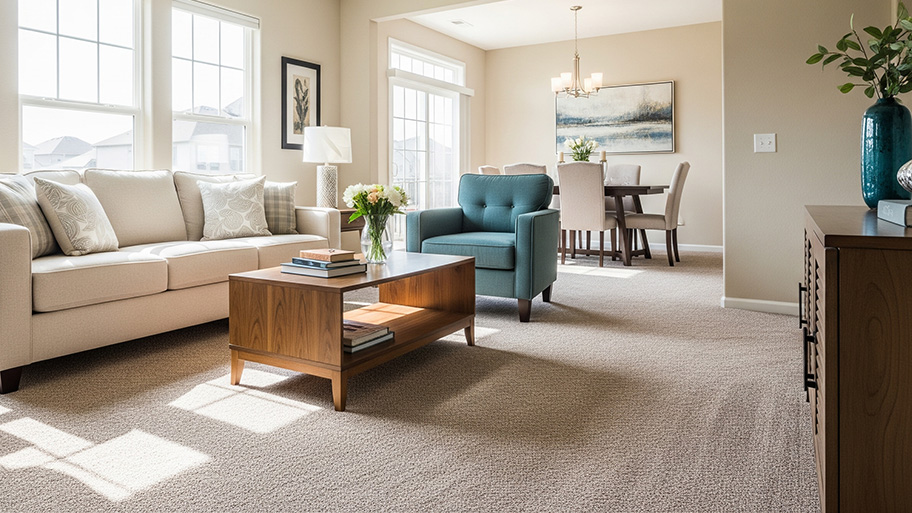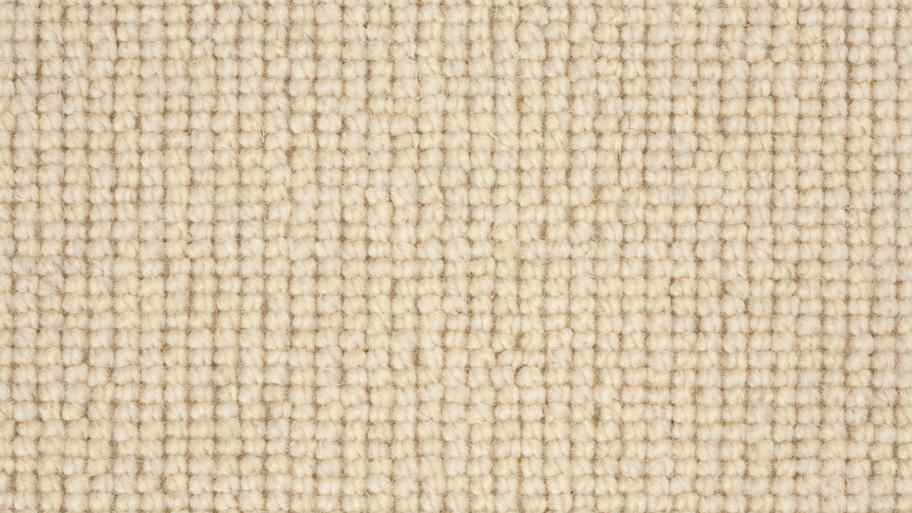
Carpet installation costs vary depending on the type of carpet, difficulty of the installation, and labor costs. We break it all down in this article.
The loops in Berber carpet handle heavy traffic but won't coddle your feet


Berber carpet’s looped construction doesn’t crush under heavy foot traffic.
Accidental spills bead on the surface, giving you time to clean before stains set in.
It’s a budget-friendly option that lasts 15 to 20 years with proper care.
Loops can snag on furniture legs, pet claws, and sharp objects.
Berber has a firmer feel than plush carpets and is less comfortable to walk on barefoot.
The pros and cons of Berber carpet come down to practicality and comfort. It’s durable and wallet-friendly, making it a sensible option for busy households. Spills sit on the surface longer due to its signature looped construction, giving you time to clean them up. The tight weave also handles foot traffic better than most other carpet styles.
However, those same sturdy loops can snag on pet claws or furniture legs, and the firm texture won't give you that plush, sink-into-it feeling you might want in a bedroom. Let’s take a closer look at how Berber will or won’t fit into your home.
Berber carpet is a looped-pile flooring style, in which yarn fibers are woven into small, uncut loops that attach directly to the backing material, creating the carpet's signature textured appearance. It originates from traditional weaving techniques used by the Berber people of North Africa and Morocco, though today's versions are machine-manufactured.
The tight loop construction sets Berber apart from cut-pile carpets, in which fiber tops are sheared off after weaving. This changes how the carpet feels underfoot and handles spills and wear. Berber can be made from wool, nylon, olefin, polyester, and newer synthetic blends, with each material affecting both price and performance.
Consult with a carpet installer who can recommend the best carpet fiber to fit your flooring project.
| Pros of Berber Carpet | Cons of Berber Carpet |
|---|---|
| Handles heavy foot traffic | Prone to snagging |
| Spill-resistant | Firmer, less cushioned feel |
| Budget-friendly or mid-range pricing | Not ideal fo rhomes with pets |
| Hides dirt and stains well | Challenging to repair |
| Durable and long-lasting | Requires careful vacuuming |

Berber carpet delivers on the basics that matter most to busy families. The loop construction that defines this flooring style creates a few practical advantages that keep your home looking good with less effort.
The tight loop construction keeps Berber carpet from crushing down under traffic, so it’s a smart option for hallways, family rooms, and other busy areas. Plush carpets can develop permanent pathways where people walk, but Berber maintains its appearance in homes with large families or frequent guests.
Berber's tightly woven loops create a surface where liquids bead up instead of immediately soaking into the fibers. This gives you time to grab a towel and clean up a spill before it turns into a permanent stain.
Since the cutting process is skipped, Berber carpet costs less to manufacture. Most synthetic Berber options are cost-effective or fall into mid-range pricing, and even wool Berber costs less than premium cut-pile carpets. Consider carpet installation costs, including materials and labor, as you budget for the complete project.
The flecked pattern in Berber carpet naturally camouflages dirt, pet hair, and minor stains between cleanings. The darker specks scattered throughout the lighter base color work like built-in camouflage for regular wear and tear, meaning your carpet looks cleaner when life gets messy.
Quality Berber carpet can last 15 to 20 years with maintenance, outlasting many other residential carpet styles. This is because the loop construction distributes weight and pressure more evenly across the surface, preventing fiber breakdown that makes carpets look worn and flattened over time.
Berber is practical, but it comes with trade-offs. These drawbacks won't matter to every household, but they can be deal-breakers depending on your lifestyle and priorities.
The loops that make Berber durable also create opportunities for furniture legs, high heels, or sharp objects to catch and pull on the carpet. Once a loop gets snagged, it can create a run that spreads across the carpet if you don't address it right away. Something as simple as dragging a chair across the room can cause noticeable damage that's difficult to fix.
Berber carpet doesn't offer the plush, sink-into-it comfort of cut-pile styles, especially when made from stiffer materials like olefin. The tight loops create a firmer surface that some people find less comfortable for walking barefoot or making blanket forts.
Pet claws can easily catch in Berber loops, potentially injuring your pet or damaging the carpet. Cats may find the texture appealing for scratching, which can quickly destroy sections of the carpet. Thanks to the spill-resistant surface, pet accidents will be easier to clean up, but pet damage can be costly.
When a Berber carpet is damaged, you often need to replace entire sections rather than patching small areas. The loop construction makes it difficult to blend repairs, and color matching can be tricky with flecked patterns. Watch out for these signs that you need to replace your carpet.
When cleaning Berber carpet, you'll need to turn off or avoid using the beater bar on your vacuum to prevent catching and pulling the loops. Instead, use your vacuum's carpet setting without the rotating brush, or switch to a suction-only mode if your vacuum has that option. This means vacuuming can take more attention to detail and time since you can't use the automatic settings that work for other carpet types.
If Berber carpet doesn't match what you're looking for, here are other flooring options that might work better for your space:
Cut-pile carpet: Styles like plush, saxony (dense, upright fibers), and frieze (twisted, curly fibers) resist snagging better than loops and give you a softer feel underfoot.
Textured carpet: This option combines cut and loop fibers to hide footprints and vacuum marks, and it can be more comfortable than traditional Berber.
Luxury vinyl plank (LVP): LVP gives you the look of hardwood with waterproof protection. You’ll need to sweep and mop the floor instead of vacuuming.
Laminate flooring: You’ll get durability similar to Berber but with a hard surface that's simple to clean and still won't snag or stain.
Carpet tiles: These tiles offer the comfort of carpet, but it’s easier to replace individual sections that are damaged or stained.
Comparing the different types of carpet fibers can help you find one that matches your preferences and goals.
Berber carpet works best in homes where durability and practicality take priority over plush comfort. In other words, it’s a solid option for big families with young children. It can also work well for high-traffic areas like hallways and living rooms. It’s the type of carpet that keeps up with your daily life.
However, you might want to go with an alternative if you have pets with sharp nails or prefer ultra-soft carpet. Also, Berber carpet is easily snagged, so it might not be a good fit if you like to rearrange your furniture. In these cases, consider flooring alternatives to carpet for your home improvement project.
If Berber sounds like it matches your needs and lifestyle, the next step is hiring a pro to install it for the best performance and longevity. Hire a carpet installer near you to get accurate measurements and a proper installation that will last for years.
From average costs to expert advice, get all the answers you need to get your job done.

Carpet installation costs vary depending on the type of carpet, difficulty of the installation, and labor costs. We break it all down in this article.

The cost to carpet stairs depends on the number of stairs, material choice, and staircase type. Read on to calculate your project expenses

Not only are carpet tiles easier to install than carpet, but they’re often more affordable. So, how much does carpet tile installation cost? Let’s take a look.

Will carpet installers move furniture? Here’s what you need to know and how you can prepare your space before your carpet project.

Elevate your eating space with our options for the best carpet for your dining room. Discover the benefits of plush wool, durable nylon, and more.

Curious about the differences between carpet tiles versus carpet? We’ve gathered everything you need to know about these flooring options.